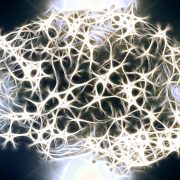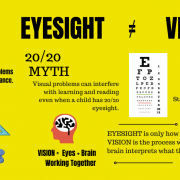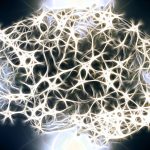This article is adapted from Learning Magazine
Written By: Mitchell Scheiman, OD, FCOVD
Richard, a 12-year old in your 7th grade class, is a verbal child. From what you’ve seen early in the year, you expect him to be an above average student. But gradually, you realize that he is struggling just to maintain average grades. Looking at his past records, you see the same pattern: strong language and verbal skills, but marginal performance. As you try to figure out what could be wrong, you notice that Richard is easily distracted. He almost never completes in-class silent reading assignments and consequently does poorly on answering the follow up questions. On homework, if the task is creative writing, he does well. But if he has to read for understanding, he seems lost.Watching more closely, you also notice that Richard often rubs his eyes when he’s reading. Sometimes he complains that he has a headache or tired eyes.
Visual Efficiency Problems
Richard’s behavior is characteristic of a child with an undetected vision problem. And there are many Richards. Experts estimate that 10% to 15% of school-age children have vision problems significant enough to interfere with academic performance. For children with learning problems, the figures are as high as 30% to 60%. And many of these children have passed the annual school vision screening with flying colors.Do you have a student with an undetected vision problem? The charts on the next two pages may help you discover why a student you think should be doing fine is failing. If one of your students exhibits some of these symptoms, make sure he gets tested by a professional as soon as possible. Help that could dramatically improve his school performance is available.These kinds of sight problems interfere with a child’s ability to clearly and comfortably see and take in information for sustained periods of time. Many of these problems don’t surface until the upper elementary grades or junior high, when children are required to cover significantly more reading material. Visual efficiency problems include nearsightedness, farsightedness, astigmatism, and problems with focusing, tracking and eye teaming. Nearsightedness is the condition most commonly detected by the traditional school vision screening. But nearsighted children tend to be some of the best readers, and the traditional screening doesn’t necessarily identify any of the other problems.
Vision and Learning
Most people think that a child who has passed the annual school vision screening has “good vision” and can see the board and his textbooks clearly.Unfortunately, this is a serious misconception because the traditional school eye exam doesn’t test aspects of vision required for reading. And sadly, the perception that everything’s okay can mask significant learning-related vision problems.The key to understanding the relationship between vision and learning is realizing that vision is more than just being able to see the letters on the 20/20 line of a chart placed 20 feet away. Visual problems can be divided into two broad categories – visual efficiency and visual processing.
Nearsightedness (Myopia)
The inability to clearly see things in the distance
Symptoms:
- Squints
- Gets close to board
Farsightedness (Hyperopia)
The inability to clearly see closeup things
Symptoms:
- Rubs eyes
- Has watery eyes
- Complains of blurred vision
Astigmatism
This condition causes blurred vision for distant and closeup things
Symptoms:
- Complains of blurred vision
- Holds book at close distance
Eye Teaming disorders (Binocular Vision)
A variety of conditions in which the eyes tend to drift inward, outward, or upward
Symptoms:
- Has intermittent double vision
- Closes or covers one eye
- Says letters or words appear to move
- Loses place
- Is inattentive
- Rubs eyes
- Has watery eyes
- Has poor reading comprehension
Eye Focusing disorders (Accommodation)
The inability to contract or relax the eye focusing muscles to allow for clear, stable vision
Symptoms:
- Has blurred vision when looking from board to book or book to board
- Holds things very close
- Has headaches when reading
- Is tired at the end of the day
- Is inattentive
- Rubs eyes
- Has watery eyes
- Complains of blurred vision
- Has poor reading comprehension
Eye Tracking disorders (Saccadic Dysfunction)
Inadequate ability to scan along a line of print and move the eyes from one point in space to another
Symptoms:
- Moves head excessively when reading
- Loses place frequently
- Skips lines when reading
- Uses finger to keep place
- Has poor reading comprehension
- Has short attention span
Visual Processing Problems
These problems have to do with the child making sense of incoming visual information. They include difficulty with laterality, directionality, visual form perception, visual memory, and visual motor integration.In contrast to visual efficiency disorders, many of which surface in the middle grades, visual processing problems tend to sabotage learning for children in the early grades even kindergartners. Children with visual processing problems may be difficult to teach because they fail to understand and grasp basic concepts and ideas.
Visual Issues Impact Learning
Directionality and Laterality Problems
Poor development right/left awareness
Symptoms:
- Has trouble learning right and left
- May read either left to right or right to left
- Reverses letters and words
- Has trouble writing and remembering letters and numbers
Faulty Visual Form Perception
The inability to discriminate among different shapes
Symptoms:
- Confuses likenesses and minor differences
- Mistakes words with similar beginnings
- Can’t recognize the same word repeated on a page
- Can’t recognize letters or even simple forms
- Can’t distinguish the main idea from insignificant details
- Has trouble learning the alphabet recognizing math facts, and learning basic math concepts of size, magnitude, and position
Faulty Visual Memory
Inability to remember what is seen
Symptoms:
- Has trouble visualizing what is read
- Has poor comprehension skills
- Has trouble learning new material
- Is a poor speller
- Has poor recall of visually presented material
- Has trouble with tasks that require more than one step
- Has trouble with math concepts
- Has trouble with sight vocabulary
Faulty Visual Motor Integration
The inability to process and reproduce visual images by writing or drawing
Symptoms:
- Has sloppy writing and drawing skills
- Can’t space letters or stay on lines
- Has poor copying skills
- Erases excessively
- Can respond orally but not in writing
- Seems to know material but does poorly on tests
Treatment
A full evaluation by a professional who has the expertise to test for both visual efficiency and visual processing disorders is the only way to detect some vision problems. When one of these hidden problems does exist, treatment involving eyeglasses, vision therapy, or both can correct it. Glasses are generally effective for nearsightedness, farsightedness, and astigmatism. They can also correct some types of focusing and eye teaming disorders. In fact, 85% to 90% of people with vision problems are treated with glasses. However, the other 10% to 15% require vision therapy. This therapeutic approach involves a series of treatments that includes using special instruments and activities under close supervision.The education and clinical training of optometrists stresses both eye health and eye function. This makes them uniquely qualified to detect and treat vision problems that interfere with school performance.To find an optometrist qualified to treat learning-related vision problems, visit the College of Optometrists in Vision Development (COVD) at www.covd.org. COVD can provide a list of its fellows in any area of the United States.It is important to understand that optometrists don’t specifically treat reading or learning problems. But along with extra help or tutoring from parents and teachers, an optometrist can correct the vision problems that may be blocking the possibility of learning.
Nebraska Visual Integration Center is a Vision Therapy office in Omaha, Nebraska that specializes in the diagnosis and treatment of visual efficiency (visual skills) and visual processing issues that impact school and learning. If you think you or your child may have a hidden visual issue impacting learning, please contact our office at (402) 502-0043 or email at [email protected]. We enjoy seeing lives change by taking care of visual issues that block learning and we would love to help you.







